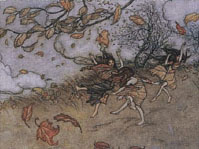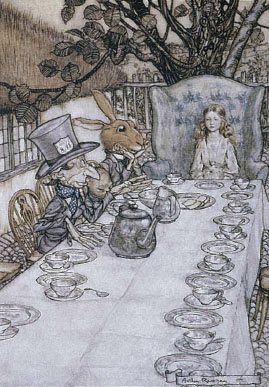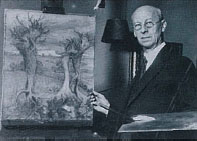
[caption id="ArthurRackhamIllustrations_img1" align="aligncenter" width="199"]

[caption id="ArthurRackhamIllustrations_img2" align="aligncenter" width="269"]

[caption id="ArthurRackhamIllustrations_img3" align="aligncenter" width="197"]

THE WORLD OF children’s books is a magical place, with tales that stir imaginations and morals that impart valuable lessons. But for little ones who cannot yet read (or for older ones who like to pretend they cannot), it is the work of illustrators such as Arthur Rackham that breathes life into fanciful characters.
Arthur was born on 19th September 1867 to Anne and Alfred Rackham, a prosperous middle-class couple living in south-east London. He was one of 12 children, and a proud cockney son. Arthur’s father worked as a clerk at the Registry of the Admiralty Court, and at age 18 Arthur followed his father’s footsteps and began clerking with an insurance company. His ambitions went beyond office work, however, and Arthur attended evening classes at the Lambeth School of Art. He occasionally sold his drawings to illustrate magazines such as Scraps and Chums and eventually earned a place as one of Pall Mall Budget’s main contributors, where his sketches of scenes from the streets of London, social functions, and celebrities of the day regularly appeared.
Rackham quit clerking to work full time as an illustrator at the Westminster Budget in 1892, and his sketches of leading personalities grew so popular that he often drew the assignment of illustrating royal events, such as the 1893 wedding of the Duke and Duchess of York, later King George V and Queen Mary. Though he contributed to the paper until 1896, the growing demand for news photography soon eclipsed illustrative journalism, and Arthur eased into the profession of book illustrator.
His first efforts appeared in an 1893 travel book, To the Other Side, by Thomas Rhodes. During the next three years he contributed illustrations for two more travel books and saw his journalistic sketches republished in composite publications. His first solo commissioned work came in 1896 with The Zankiwank and the Bletherwitch.
In the meantime, he met artist Edyth Starkie, a blue-eyed Irish girl, and they married in 1903. Edyth had built a reputation as a talented portrait painter. They complemented each other well. According to her nephew, “Aunt Edyth was the romantic one of the family … [Uncle Arthur] was more staid than my aunt, and with his prim precise English manner was an admirable foil and when m company she would always do her best to shock him.”
WHERE TO BUY
Vintage and second-hand bookshops still carry early editions of Rackham’s books, but they are increasingly hard to find. Amazon.com features reprints of his work.
Online shoppers can order vintage Rackham prints at www.forwoodsdirect.com, the excellent on-line extension of Forwood’s gallery in Hay-on-Wye, Wales. Most of Forwood’s stock of Rackham illustrations (more than 300 at press time) cost from about $18 to $30.
Galleries in Britain that hold collections of the artist’s drawings and paintings include the Leeds City Art Gallery, the Victoria and Albert Museum, and the British Museum.
RACKHAM’S BREAKTHROUGH WORK came in 1900 with the illustrated Brothers Grimm Fairy Tales. The illustrator’s fanciful style had yet to fully emerge, but the book became an immediate success, with new editions released periodically throughout his lifetime. Later in his career Rackham wrote to a friend that “In many ways I have more affection for the Grimm drawings than for other sets. It was the first book I did that began to bring success.” Still, other successes quickly followed. His 1905 edition of Washington Irving’s classic Rip Van Winkle, with 51 colour illustrations, made him the most sought-after decorative illustrator in England.
From then on, practically every year saw a new Rackham publication: Peter Pan in Kensington Gardens (1906); Alice’s Adventures in Wonderland (1907); A Midsummer-Night’s Dream (1908); The Rhinegold and the Valkyrie (1910); Siegfried and the Twilight of the Gods (1911); Aesop’s Fables (1912); and Mother Goose (1913).
Meanwhile, Rackham added to his reputation and his pocketbook by showing and selling original art at the Leicester Galleries in London. The illustrator’s distinct style had by now fully matured. Bold, at times heavy, pen strokes formed the basis of his works. To these he added moody, subdued colours in light, almost transparent washes. He gave elegance and dignity to his human and fairy subjects, and just the right amount of the grotesque to gnomes, dwarves, and all other manner of characters. His style captured the imagination, and the demand for his work grew until he found himself pledged to projects for years in advance.
‘In many way I have more affection for the Grimm drawings than for other sets. It was the first book I did that began to bring success.’
The appeal of Rackham’s art stemmed from more than mere’ talent, however; it reflected a heart-felt commitment and responsibility to bring the best to young, imaginative minds. In The Junior Book of Authors (1934), Rackham observed, “I can only say that I firmly believe in the greatest stimulating and educative powers of imaginative, fantastic, and playful pictures and writings for children in their most impressionable years …. ” He understood that children were a discerning audience. “Nor are they at all blind to decorative or arbitrarily designed treatment in art, any more than they are to poetic or rhythmic form in literature. And it must be insisted on that nothing less than the best that can be had, cost what it may (and it can hardly be cheap) is good enough for those early impressionable years when standards are formed for life. Any accepting, or even choosing, art or literature of a lower standard, as good enough for children, is a disastrous and costly mistake.” He acted on this belief when choosing toys for his only child, Barbara, born in 1908, and insisted that she have only pretty dolls.
RACKHAM DUTIFULLY ATTENDED to even his smallest fans, always responding to their letters with personal thoughtfulness. To one young admirer who invited him to visit in 1910, he responded, “It is very kind of you to want me to come & stay with you, but I am afraid I cannot manage to do that though I know I should enjoy it. But I am kept so busy at home over my books & pictures that I have not the time to accept half of the kind invitations I receive.”
By 1912 the award-winning artist’s paintings appeared in galleries all over Europe and later in the United States. But despite his fame, Rackham maintained a low-key lifestyle and preferred to always wear a navy-blue suit with a stiff white shirt and simple tie. When one suit wore out, his tailor crafted a new one of the same type.
Demand for Rackham’s illustrations continued unabated throughout the next two decades. His last project, The Wind in the Willows, was a labour of love and one that he had been forced to decline 30 years earlier because of scheduling. He had long desired to illustrate this “splendid book” and just finished it before his death from cancer on 6th September 1939. Three years earlier, writer R.H. Ward had penned a description of the artist: “I have the recollection of a smallish, ageing, almost wizened person, with a bald domed forehead and a very wide and elfish grin: a gnome perhaps, though an entirely benevolent one ….”
LARUE SCOTT is a devoted Anglophile who lives in Gettysburg, Pennsylvania.





Comments